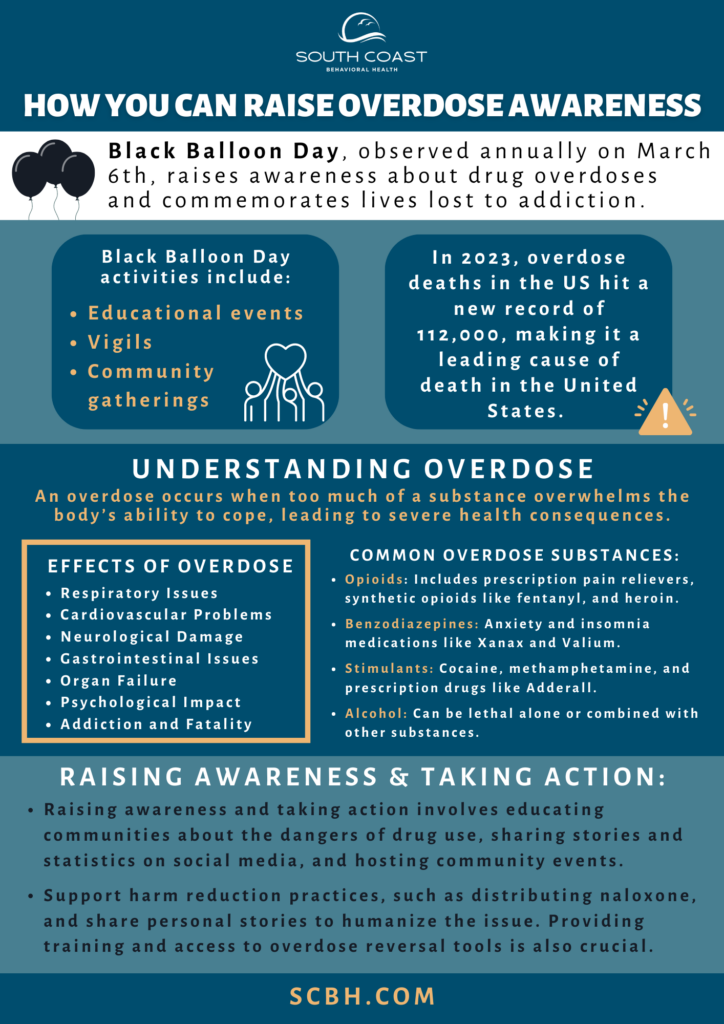In 2023, overdose deaths in the US hit a new record of 112,000, making it a leading cause of death in the United States. That’s more deaths than due to shootings or car accidents. The staggering human toll of this ongoing tragedy and crisis has inspired awareness initiatives like Black Balloon Day. Black Balloon Day is a day of remembrance that takes place on March 6th. It’s a day to commemorate those who lost their lives to overdose.
What Is Black Balloon Day?
Black Balloon Day is an event dedicated to raising awareness about drug overdoses and commemorating the lives of loved ones lost to drug addiction. It’s observed each year on March 6th, serving as a day of remembrance and awareness for those who have died or suffered from drug overdoses. The day encourages people, communities, and organizations to display black balloons, often outside their homes or in public spaces, as a symbol of mourning and a call to action against the ongoing drug epidemic.
The initiative for Black Balloon Day began with a family in the United States in 2016 following the death of a family member due to an overdose. They chose a black balloon as a symbol of mourning and a visual representation of the loss felt by families and communities affected by drug-related deaths. Those participating in the day should hang a black balloon outside of their home or post a virtual balloon on social media and use the hashtag #blackballoonday to raise awareness.
Since its inception, Black Balloon Day has gained traction across the United States and in various parts of the world, with individuals, families, communities, and organizations participating to honor lives lost and to spread awareness about the dangers of drug abuse and the importance of addiction treatment programs and support services.
The day features various activities, including educational events, vigils, and community gatherings, aimed at highlighting the impact of drug addiction on our loved ones and overdose deaths. It also serves as a reminder of the importance of compassion, support, and understanding for those struggling with addiction, as well as the need for accessible and effective treatment options.
What Does It Mean to Overdose?
When someone overdoses, it means they took too much of a certain substance, like drugs or alcohol. Overdosing occurs when the amount ingested surpasses the level at which the substance can be metabolized and managed by the body, leading to toxic effects. Both physical and psychological consequences can occur as a result.
Consequences of a substance overdose may include:
Respiratory Depression
Many substances, especially opioids, can slow breathing, leading to hypoxia (lack of oxygen to the brain), which can cause coma or death.
Cardiovascular Problems
Overdoses can lead to increased heart rate, high or low blood pressure, arrhythmias (irregular heartbeats), and even heart attacks.
Neurological Effects
These can range from mild (dizziness, confusion, headaches) to severe (seizures, strokes, coma, and permanent brain damage).
Gastrointestinal Distress
Symptoms can include nausea, vomiting, abdominal pain, and diarrhea. Severe cases may lead to dehydration or chemical imbalances in the body.
Renal Failure
Some substances can cause direct toxic effects on the kidneys or lead to conditions (like rhabdomyolysis, where muscle tissue breaks down) that overload the kidneys with toxins.
Liver Damage
The liver is crucial for metabolizing substances, and an overdose can lead to acute liver failure or long-term damage, impacting the body’s ability to filter toxins.
Psychological Effects
Beyond the immediate physical health risks, overdosing can have long-term psychological effects, including anxiety, depression, and post-traumatic stress disorder (PTSD).
Addiction and Dependence
Repeated overdoses, especially with substances like opioids, can lead to a deepening cycle of addiction and physical dependence.
Death
In the most severe cases, overdosing can lead to death. This is particularly true if the overdose is not treated right away or if the substance involved is very toxic.
Legal and Social Consequences
Overdosing can also lead to legal issues, hospitalization, and challenges with employment and relationships, further impacting an individual’s life and well-being.
While death does not always occur during a substance overdose, it is a distinct possibility, especially with substances like alcohol or opioids. More people in the U.S. die due to overdose than due to shootings or car accidents. Black Balloon Day raises awareness of this issue.

Looking for quality substance abuse treatment that’s also affordable? South Coast accepts most major insurance providers. Get a free insurance benefits check now.
Check Your CoverageWhat Are the Most Common Drugs People Overdose?
In the United States, the landscape of drug overdoses has evolved, but certain substances rank as the most common culprits behind overdose incidents.
The most common drug overdoses include the following substances:
- Opioids
- Benzodiazepines
- Stimulants
- Alcohol
These drugs represent the most common causes of overdose deaths in the U.S., reflecting broader public health challenges, including the opioid crisis and the prevalence of prescription medication abuse. Efforts to reduce overdose deaths include improving prescription drug monitoring programs, increasing access to treatment for substance use disorders, and expanding the availability of naloxone. This life-saving drug can reverse opioid overdoses. Days like Black Balloon Day, which help raise awareness of the overdose epidemic, also play an important role in prevention.
Opioids
This class of drugs includes prescription pain relievers (such as oxycodone, hydrocodone, and morphine), synthetic opioids (such as fentanyl), and heroin. Opioid addiction is particularly dangerous because it can depress the respiratory system to the point of failure, leading to death. Synthetic opioids like fentanyl and nitazenes are especially problematic due to their high potency, often being 50 to 100 times more potent than morphine, making them a leading cause of opioid-related overdoses.
The statistics surrounding opioid overdoses are alarming. According to the latest numbers from the National Center for Drug Abuse Statistics, 67% of all overdose deaths in the United States in 2023 involved an opioid. It’s estimated that 136 Americans die of an opioid overdose each day. Many stores and pharmacies around the country now stock Naloxone, an opioid overdose reversal drug that can help save lives.
Benzodiazepines
Often prescribed for anxiety, insomnia, and seizures, drugs like alprazolam (Xanax), diazepam (Valium), and lorazepam (Ativan) can cause severe central nervous system depression when taken in high doses or combined with other substances, particularly opioids.
It is crucial to be cautious with the dosage and avoid mixing medications that can potentiate the depressant effects. Awareness and education about the dangers of drug interactions are essential in preventing overdose incidents.
Stimulants
Along with opioids and benzodiazepines, stimulants like cocaine and methamphetamine are substances associated with overdoses. This includes prescription medications such as amphetamines (Adderall) and methylphenidate (Ritalin), as well as illicit drugs like cocaine and methamphetamine. These drugs can cause severe cardiovascular issues, including high blood pressure, heart attacks, and strokes. Overdoses of stimulants can lead to heart attacks, strokes, and severe psychological effects. In 2022, stimulant-related overdoses claimed just under 58,000 lives, causing nearly 5 times the amount of deaths in 2015.
Alcohol
Often overlooked in discussions about overdoses, alcohol is a common cause of overdose, either by itself or when combined with other drugs. Excessive alcohol intake can lead to alcohol poisoning, which affects the brain’s ability to control critical life-support functions such as breathing, heart rate, and temperature control. In the United States, around 2,500 people die from alcohol poisoning each year.
Overdose Deaths by Demographic
Men between the ages of 25 and 34 are the most likely of any age group to die from an overdose. In fact, men of all ages are more likely to die from an overdose than women. Digging deeper, the numbers show that Black or African American males are more likely than any other race to experience an overdose.
West Virginia saw the highest rate of overdose deaths in 2023, with 52.8 per 100,000 residents. That rate is 155% higher than the national average. Compare that to California, which had an overdose rate of 15 per 100,000 residents. That rate is 27% lower than the national average. Nebraska has the lowest rate of overdose death in the country, with 8.7 per 100,000 residents.
Get confidential help from our addiction treatment specialists in Orange County. Call to join our rehab program today!
Call 866-881-1184Raising awareness about overdose is crucial in helping to prevent drug-related deaths and supporting those affected by substance abuse. Here are some effective ways to help raise awareness for overdoses, including the mention of Black Balloon Day:
Educational programs
implementing educational programs in schools, workplaces, and community centers that inform individuals about the risks of drug use, signs of overdose, and the importance of seeking help can be powerful. These programs can include information on how to use naloxone, a life-saving medication used for opioid overdose reversal.
Social media campaigns
Use social media platforms to share stories, facts, and statistics about overdoses. Engaging content such as infographics, videos, and interactive posts can help spread the message.
Community events
Organize or participate in community events such as workshops, seminars, and health fairs to educate the public about overdose prevention and support services available. These events can provide a platform for survivors and families to share their experiences, which can be powerful and impactful.
Supporting harm reduction policies
Advocating for and supporting harm reduction policies and practices, such as safe injection sites and access to clean needles, can help reduce the risk of overdose and spread awareness about safer drug use practices.
Promotion and participation
Black Balloon Day can involve hanging black balloons outside your home or workplace, sharing stories and messages on social media using specific hashtags, and attending or organizing local events and vigils.
Collaboration with local health departments and organizations
Partnering with local health departments, hospitals, and non-profit organizations focused on addiction and overdose prevention can amplify efforts to raise awareness. These partnerships can help gain access to resources, expertise, and platforms for broader outreach.
Personal stories and testimonials
Sharing personal stories and testimonials from individuals and families affected by overdose can humanize the issue and create a more profound impact. You can share these stories through various platforms, including blogs, podcasts, social media, and public speaking events.
Training and distribution of naloxone kits
Offering training on recognizing the signs of an overdose and administering naloxone can save lives. Distributing naloxone kits to the public and educating them on their use empowers individuals and raise awareness about overdose prevention.
By employing these strategies, individuals and communities can play a significant role in raising awareness about the dangers of overdose, promoting prevention strategies, and supporting those affected by substance use disorders.
Raising awareness about overdose is crucial in helping to prevent drug-related deaths and supporting those affected by substance abuse.
Finding Treatment to Prevent Overdoses
South Coast Behavioral Health is a leading provider of addiction and mental health treatment programs. Our therapy staff combines evidence-based and holistic therapies to create individualized treatment plans that consider each client’s clinical needs, physical and mental health, treatment preferences, and life experiences. The best way to prevent an overdose is to stop using drugs and alcohol. Our rehab programs in Orange County provide a safe and effective recovery, minimizing the risk of overdose and helping someone get back on the right track.
With so many lives lost to substance abuse, it’s clear we need to take action and do everything possible to educate people on the dangers of addiction. If you or a loved one is struggling with addiction to dangerous drugs with a potential for overdose, the best thing to do is contact South Coast Behavioral Health and learn more about treatment. Our admissions team is available at (866) 881-1184 to answer any questions you may have.
- Woman Initiates Black Balloon Day To Recognize Victims Of Drug Addiction – CBS Boston (cbsnews.com)
- Overdose deaths due to fentanyl spark debate over treatment : NPR
- Drug Overdose Death Statistics [2023]: Opioids, Fentanyl & More (drugabusestatistics.org)
- Estimates of Alcohol Poisoning Deaths | Minnesota Department of Health










